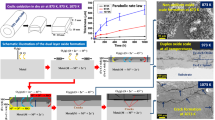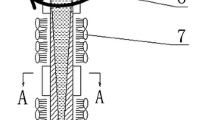Abstract
High SiMo cast iron components in automotive exhaust systems are exposed to high-temperature oxidation over time. Quantitative analysis of formed oxide scale is therefore important for the assessment of a component durability. The brittle nature of multilayered scale and thermal stress limits capture of a true topology using traditional 2D destructive cut and polish methods. In this study, nondestructive high spatial-resolution 3D µCT analysis was performed on 2.90-mm-diameter oxidized specimens which permitted direct observation with 3.5 µm pixel resolution. The specimens were oxidized in three sequential time steps for a total 100 h at 700 °C and 800 °C in air and combustion gas atmospheres. A MATLAB-coded algorithm was used to quantify the topology, thickness variation in internal and external scale layers, and scale/metal interface unevenness. Scale topology was linked to oxidation temperature and gas atmosphere. A water vapor environment increases scale/metal interface unevenness and scale layer thickness irregularity which were related to an accelerated oxidation rate.














Similar content being viewed by others
References
L. Cheah and J. Heywood, Meeting U.S. passenger vehicle fuel economy standards in 2016 and beyond. Energy Policy 39, (1), 2011 (454–466).
M. Ekström, Oxidation and corrosion fatigue aspects of cast exhaust manifolds, (KTH Royal Institute of Technology, Stockholm, 2015).
M. P. Brady, et al., Long-term oxidation of candidate cast iron and stainless steel exhaust system alloys from 650 to 800 °C in Air with Water Vapor. Oxidation of Metals 82, (5–6), 2014 (359–381).
F. Tholence and M. Norell, High Temperature Corrosion of Cast Alloys in Exhaust Environments I-Ductile Cast Irons. Oxidation of Metals 69, (1–2), 2007 (13–36).
D. Oliver and M. Sephton, External corrosion resistance of steel and ferritic stainless steel exhaust systems. Journal of the Southern African Institute of Mining and Metallurgy 103, (2), 2003 (93–100).
M. Ekström and S. Jonsson, High-temperature mechanical- and fatigue properties of cast alloys intended for use in exhaust manifolds. Materials Science and Engineering: A 616, 2014 (78–87).
A. Vaško and M. Krynke, Fatigue properties of nodular cast irons alloyed by Si, Mo And Cu. System Safety: Human—Technical Facility—Environment 1, (1), 2019 (738–744).
S.C. Stan et al., Structure Characteristics of Silicon Alloyed Ductile Cast Iron. IOP Conference Series: Materials Science and Engineering, 2018. 416.
A. Moya, High temperature corrosion in exhaust application for heavy-duty trucks. 2019.
S. Méndez, et al., Effect of silicon and graphite degeneration on high-temperature oxidation of ductile cast irons in open air. Oxidation of Metals 91, (1–2), 2018 (225–242).
L. L. Liu, Q. Q. Guo and Y. Niu, Transition Between Different Oxidation Modes of Binary Fe–Si Alloys at 600–800 °C in Pure O2. Oxidation of Metals 79, (1), 2013 (201–224).
M. Ekström, P. Szakalos and S. Jonsson, Influence of Cr and Ni on high-temperature corrosion behavior of ferritic ductile cast iron in air and exhaust gases. Oxidation of Metals 80, (5–6), 2013 (455–466).
T. Sjögren and I. L. Svensson, The effect of graphite fraction and morphology on the plastic deformation behavior of cast irons. Metallurgical and Materials Transactions A 38, (4), 2007 (840–847).
A. Ebel, et al., High-temperature oxidation of a high silicon SiMo spheroidal cast iron in air with in situ change in H2O content. Materials Science Forum 925, 2018 (353–360).
Y.-J. Kim, H. Jang and Y.-J. Oh, High-temperature low-cycle fatigue property of heat-resistant ductile-cast irons. Metallurgical and Materials Transactions A 40, (9), 2009 (2087–2097).
D.S. Forsyth, Non-destructive testing for corrosion. Corrosion Fatigue and Environmentally Assisted Cracking in Aging Military Vehicles (RTO-AG-AVT-140), 2011.
C. Staff, 3 Essential Types of Material Destructive Tests. 2017 November 2, 2017 May 7 2020]; https://www.corrosionpedia.com/3-essential-types-of-material-destructive-tests/2/6649.
C. C. Fu, Introduction of Non-Destructive Test. 2011: cee.umd.edu.
J. Kinney, et al., Three dimensional X-ray computed tomography in materials science. MRS Bulletin 13, (1), 1988 (13–18).
S. R. Stock, Recent advances in X-ray microtomography applied to materials. International Materials Reviews 53, (3), 2008 (129–181).
Z. Lu, et al., Oxidation and microstructure of SiCf/SiC composites in moist air up to 1600 °C by X-ray tomographic characterization. International Journal of Applied Ceramic Technology 17, (3), 2020 (874–885).
Z. Yang, H. Yuan and H. Liu, Evolution and characterization of cyclic thermal shock-induced thermomechanical damage in oxide/oxide ceramics matrix composites. International Journal of Fatigue 120, 2019 (150–161).
Z. Yang, H. Liu and H. Yuan, Micro-porosity as damage indicator for characterizing cyclic thermal shock-induced anisotropic damage in oxide/oxide ceramic matrix composites. Engineering Fracture Mechanics 220, 2019 (106669).
C. Löffl, H. Saage and M. Göken, In situ X-ray tomography investigation of the crack formation in an intermetallic beta-stabilized TiAl-alloy during a stepwise tensile loading. International Journal of Fatigue 124, 2019 (138–148).
N. Dahdah, et al., Influence of the casting process in high temperature fatigue of A319 aluminium alloy investigated by in-situ X- ray tomography and digital volume correlation. Procedia Structural Integrity 2, 2016 (3057–3064).
N. Dahdah, et al., Damage investigation in A319 aluminium alloy by X-ray tomography and digital volume correlation during in situ high-temperature fatigue tests. Strain 52, (4), 2016 (324–335).
S. Dezecot, et al., 3D characterization and modeling of low cycle fatigue damage mechanisms at high temperature in a cast aluminum alloy. Acta Materialia 123, 2017 (24–34).
Z. Wang, et al., In-situ SEM investigation on fatigue behaviors of additive manufactured Al–Si10–Mg alloy at elevated temperature. Engineering Fracture Mechanics 214, 2019 (149–163).
A. Yadollahi, et al., Effects of building orientation and heat treatment on fatigue behavior of selective laser melted 17-4 PH stainless steel. International Journal of Fatigue 94, 2017 (218–235).
K. Eguchi, T. L. Burnett and D. L. Engelberg, X-Ray tomographic characterisation of pitting corrosion in lean duplex stainless steel. Corrosion Science 165, 2020 (108406).
J. Zhou, et al., Quantitative characterization of high temperature oxidation using electron tomography and energy-dispersive X-ray spectroscopy. Scientific reports 8, (1), 2018 (1–8).
MatLab Software. The MathWorks Inc., https://www.mathworks.com/products/matlab.html.
W. S. Rasband, ImageJ Software. 1997, Bethesda, MD., https://imagej.nih.gov/ij.
Acknowledgement
This material is based upon work supported by the U.S. Department of Energy’s Office of Energy Efficiency and Renewable Energy (EERE) under the Award Number DE-EE0008458. The X-ray Microanalysis Core was supported by NSF EAR IF #1636643.
Author information
Authors and Affiliations
Corresponding author
Ethics declarations
Conflict of interest
The authors declare that they have no conflict of interests.
Additional information
Publisher's Note
Springer Nature remains neutral with regard to jurisdictional claims in published maps and institutional affiliations.
Rights and permissions
About this article
Cite this article
Lekakh, S.N., Tucker, W., Bofah, A. et al. Quantitative µ-CT Analysis of Scale Topology Formed During Oxidation of High SiMo Cast Iron. Oxid Met 94, 251–264 (2020). https://doi.org/10.1007/s11085-020-09989-0
Received:
Revised:
Published:
Issue Date:
DOI: https://doi.org/10.1007/s11085-020-09989-0




